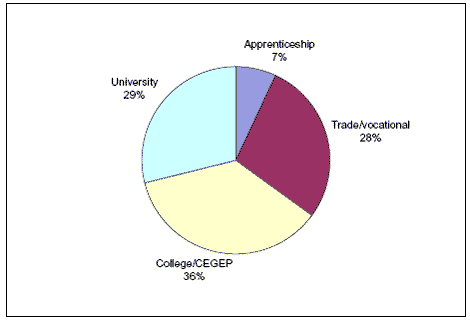
As Figure 5.1 illustrates, in 2002, adult learners over the age of 25 were more likely to pursue a college diploma (36 percent) than either a university degree (29 percent) or a trades or vocational certificate (28 percent).26 Only 7 percent of adult learners were pursuing a registered apprenticeship.

Source: Authors’ calculations using the Adult Education and Training Survey (2003)
The 2005 Canadian College Student Survey (Prairie Research Associates, 2005), allows us to take a closer look at the types of college programs in which adults are enrolled. The survey provides a demographic profile of students of all ages who are enrolled in college programs across Canada. Table 5.2 shows the distribution by age of the participation in different college programs. Overall, adults over 25 represent almost 27 percent of the college population. Among students enrolled in a career or technical program (regular diploma programs), 30 percent of students are over the age of 25. About 12 percent fall into the 25-29 age category, 11 percent are 30-39, and 7 percent are over 40. Similarly adults over the age of 25 make up an even higher proportion of the access/upgrading students (46 percent). As we suspected (but were unable to confirm when we were using the Adult Education and Training Survey), a non-trivial proportion of these college students over the age of 25 are enrolled in post diploma programs (36 percent). This means that these adults already had a post-secondary degree or diploma before they entered their current program and therefore, these adults are not likely to fall into our target population.
26 “The distinction between “college” and “trades-vocational” is based primarily on program requirements. Specifically, “college” programs generally require a secondary school diploma and are primarily of a general or professional nature (such as business, commerce or health sciences). In contrast, “Trade-vocational” programs do not usually require secondary school completion and these programs are primarily career-oriented (e.g., machining, plumbing, hairdressing, etc.). This category also includes students in other types of programs, such as pre-employment, pre-apprenticeship, language training, special contract training, job readiness training, academic upgrading and preparatory training.